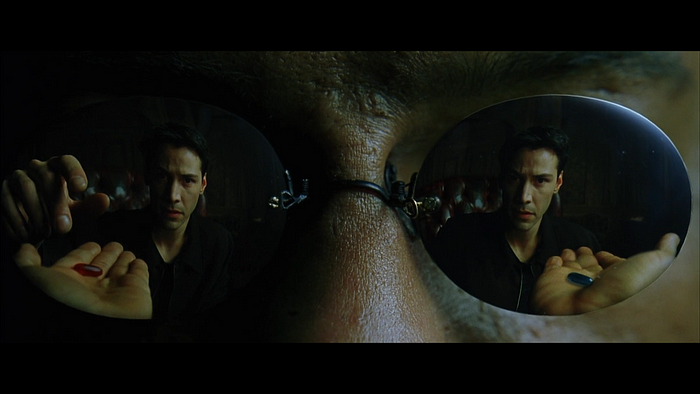“The Matrix”, Revisited.
The Matrix is one of the most famous and most culturally significant movies of the last 25 years. Directed by Lilly and Lana Wachowski, it is a dystopian science fiction movie that depicts (almost) all of humanity enslaved by a race of machines, and injected into a simulation known as The Matrix in order to keep them subservient. This is done in order to use them as a cheap energy source for the machines, after nuclear war with the humans caused the sky to be washed out and sunlight unable to reach the Earth’s surface.

Keanu Reeves is cast as the movie’s protagonist, Thomas Anderson, a.k.a “Neo”. He was an ordinary plant inside The Matrix, when he was one day “woken up” and brought into the rebellion against the machines. He is recruited by a man named Morpheus (played by Lawrence Fishburne) who acts as his mentor and his guide, to both the outside world, and the digital.

A few of the reasons why The Matrix is so widely praised is because of its numerous thematic and philosophical moments. The film is one of the “cyberpunk” genre, which usually portray a dark, tech-filled future where either machines/AI has taken over the world, or capitalistic and greedy corporations rule the world (kind of like today’s scenario). The Matrix takes the former approach and showcases the potential horrors of malicious AI. The Matrix is a horribly realistic simulation that mirrors real life, and chooses to trap all humans inserted in it that way.


One of the main antagonists of the movie is a sentient hunter program, known only as Agent Smith. Played by Hugo Weaving, Smith’s only purpose in the Matrix is to hunt down all “unplugged” humans in the Matrix and eliminate them. In a specific scene in the movie, he states that humanity is a disease, and can never exist in a state of utopia, or total happiness. The machines know this, because the first few iterations of the Matrix created by them were set in a perfect society full of happiness, but humans couldn’t stand it, and chose to kill themselves, perfectly representing humanity’s tendency towards violence and hate, despite it being the least productive way to achieve true happiness. This finally led the machines into creating a version of the Matrix that mirrored life on Earth in the late 20th century, which proved to be the most successful iteration.


The Matrix has also been described as a “trans allegory”. The directors, Lily and Lana Wachowski both came out as trans women shortly after The Matrix Revolutions’ release (3rd in the trilogy). As such, a lot of comparisons have been drawn in regards to the themes of the movie and the essential experience transgender individuals have. The “red pill”, which woke Neo up from the simulation, has been compared to red estrogen pills that trans women take when starting their transition. The sensation of “waking up and realising that something was wrong” has also been linked to the feeling of gender dysphoria.

The Matrix has been a landmark in the genre of science-fiction movies due to its themes of identity and rebellion, but even more so due to its spectacular (for the time) CGI and VFX. The Matrix pioneered the effect of “bullet-time”. This is an effect wherein the camera moves at a regular speed, but everything else is in slow motion, giving you the effect of actually moving at the speed of bullets.

The Wachowski sisters created a timeless classic in 1999 with this movie, and paved the way for almost every single science-fiction from that moment on. It has a star-studded cast, gorgeous VFX, groundbreaking action scenes, and a story that is still relevant today (with a sequel coming out soon!). The Matrix was one of the first movies I ever watched in my childhood, yet its effect on me hasn’t diminished one bit. I wholeheartedly recommend this movie to everyone, regardless of whether you enjoy science fiction themes or flashy action sequences or not.





